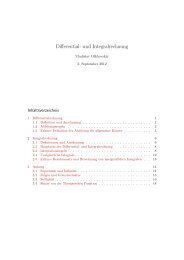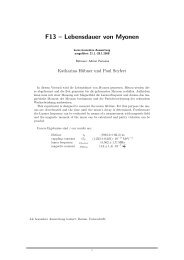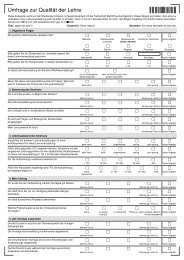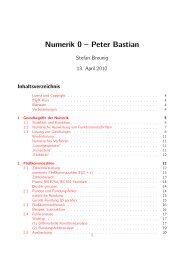Extrasolar Moons as Gravitational Microlenses Christine Liebig
Extrasolar Moons as Gravitational Microlenses Christine Liebig
Extrasolar Moons as Gravitational Microlenses Christine Liebig
You also want an ePaper? Increase the reach of your titles
YUMPU automatically turns print PDFs into web optimized ePapers that Google loves.
CHAPTER 2. GRAVITATIONAL LENSING 13<br />
−∆mag<br />
Figure 2.4: Caustics form when there are multiple lenses. The magnification map<br />
on the left corresponds to a star-planet binary, with a m<strong>as</strong>s ratio of 10 −3 . If the source<br />
trajectory crosses caustic lines this gives rise to a characteristic deviation from the<br />
Paczyński curve, a planetary signature.<br />
2.3 Search for Planets via Galactic Microlensing<br />
When we observe a Galactic lensing event, the parameters that we deal with will<br />
have typical orders of magnitude. Imagine, that we observe an alignment of two solar<br />
sized stars in our Milky Way. The background star will most probably lie in the<br />
centre of the Galactic bulge at a distance of DS = 8 kpc for there we find the highest<br />
density of stars, and indeed, that is where all Galactic lensing survey programs direct<br />
their telescopes. The lensing star will be somewhere in the foreground, DL = 6 kpc<br />
should be a safe <strong>as</strong>sumption. We can already calculate the Einstein angle, to find<br />
θE = 0.6 milliarcseconds.<br />
This is far beyond the resolution abilities of real telescopes. However, even if the<br />
individual images cannot be resolved, the magnification can still be detected if lens<br />
and source are in relative motion to each other. This p<strong>as</strong>sing of the lens in front<br />
of the source gives rise to a transient brightening <strong>as</strong> shown in figure 2.3. The<br />
light curve that results if a point lens moves in front of a point source is often called<br />
Paczyński curve, <strong>as</strong> it w<strong>as</strong> depicted in Paczyński (1986). A magnification of µ = 1.34<br />
corresponds to a difference in magnitude of ∆mag = 0.32 mag, which is e<strong>as</strong>ily<br />
detectable. Events with a magnification of µ = 100 or more are not uncommon.<br />
The search for m<strong>as</strong>sive compact halo object <strong>as</strong> potential dark matter, mentioned<br />
it section 2.1 w<strong>as</strong> not very fruitful (see e.g. Afonso et al., 2003). Microlensing<br />
experiments carried out towards the Galactic bulge had originally been intended<br />
<strong>as</strong> test experiments for the halo surveys, but Mao and Paczyński (1991) showed<br />
that roughly 10% of the lensing events must have signature of a binary companion.<br />
It w<strong>as</strong> realised, that through constantly monitoring a very large number of stars<br />
one would surely detect binary systems and possibly planets. Gould and Loeb<br />
time










